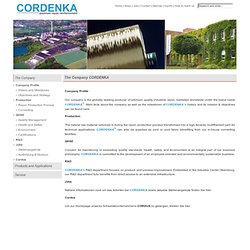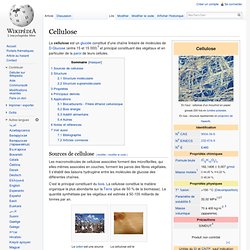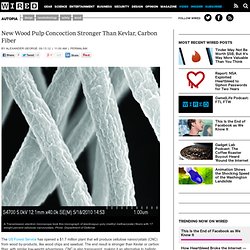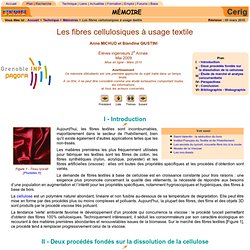

Sunil Kumar Ramamoorthy - Researcher - University of Borås. Sunil Kumar Ramamoorthy. The Company. Company Profile Our company is the globally leading producer of premium quality industrial rayon, marketed worldwide under the brand name CORDENKA®.

Main facts about the company as well as the milestones of CORDENKA`s history and its mission & objectives can be found here. Production The natural raw material cellulose is during the rayon production process transformed into a high-tenacity multifilament yarn for technical applications. CORDENKA® can also be supplied as cord or cord fabric benefiting from our in-house converting facilities. Concern for maintaining or exceeding quality standards, health, safety, and environment is an integral part of our business philosophy. CORDENKA's R&D department focuses on product- and process-improvement. Jobs Nähere Informationen rund um das Arbeiten bei CORDENKA sowie aktuelle Stellenangebote finden Sie hier. Cordus Um zur Homepage unseres Schwesterunternehmens CORDUS zu gelangen, klicken Sie hier. Www.woodyproject.eu/doc/pdf_113.pdf.
Extraction 1.pdf. Généralités bois.pdf. Généralités cellulose. Cellulose. Un article de Wikipédia, l'encyclopédie libre.

La cellulose est un glucide constitué d'une chaîne linéaire de molécules de D-Glucose (entre 15 et 15 000)[5] et principal constituant des végétaux et en particulier de la paroi de leurs cellules. Sources de cellulose[modifier | modifier le code] Les macromolécules de cellulose associées forment des microfibrilles, qui elles-mêmes associées en couches, forment les parois des fibres végétales. Il s'établit des liaisons hydrogène entre les molécules de glucose des différentes chaînes. C'est le principal constituant du bois. Le coton est une source importante de celluloseLa cellulose est le constituant principal du bois. La cellulose nanocristalline donnerait un nouveau souffle à l’industrie forestière canadienne. Une minuscule fibre promise à un billant avenir. par David Savoie Suède, 1949 : Des scientifiques découvrent la minuscule particule qui donne aux arbres leur rigidité.

Le nanocristal de cellulose, une fibre en forme d’aiguille qui compose 20 pour cent de la masse d’un arbre. Au milieu des années 1990, Derek Gray compte parmi les premiers chercheurs au Québec à étudier ces fibres qui donnent une substance appelée la cellulose nanocristalline (CNC). Le chercheur de l’Université McGill travaillait à l’époque avec un autre scientifique, Jean-François Revol, sur les propriétés iridescentes de la CNC qui, lorsqu’elle est dans l’eau ou ajoutée à du verre, permet de refléter un large spectre de couleurs. Dans le laboratoire de Montréal, M. . « Une crise recèle toujours de nouvelles possibilités », précise Jean Bouchard, chercheur principal chez FPInnovations, un institut de recherche privé sur les produits forestiers.
Service canadien des forêts : La cellulose nanocristalline. New Wood Pulp Concoction Stronger Than Kevlar, Carbon Fiber. A Transmission electron microscope took this micrograph of electrospun poly (methyl methacrylate) fibers with 17 weight percent cellulose nanocrystals.

Photo: Department of Defense The US Forest Service has opened a $1.7 million plant that will produce cellulose nanocrystals (CNC) from wood by-products, like wood chips and sawdust. The end result is stronger than Kevlar or carbon fiber, with similar low-weight advantages. CNC is also transparent, making it an alternative to ballistic glass. The real selling point is the low cost. Cellulose, found in the cell walls of plant and bacterial cells, is made of long chains of glucose molecules. LCA cellulose fibres. Comparative cradle-to-gate life cycle assessments of cellulose dissolution with 1-butyl-3-methylimidazolium chloride and N-methyl-morpholine-N-oxide - Green Chemistry. How lyocell is made - material, manufacture, making, used, processing, steps, industry, machine, Raw Materials, The Manufacturing Process of lyocell.
Lyocell is a manmade fiber derived from cellulose, better known in the United States under the brand name Tencel.

Though it is related to rayon, another cellulosic fabric, lyocell is created by a solvent spinning technique, and the cellulose undergoes no significant chemical change. It is an extremely strong fabric with industrial uses such as in automotive filters, ropes, abrasive materials, bandages and protective suiting material. It is primarily found in the garment industry, particularly in women's clothing. Background Fabrics derived from cellulose date back to the middle of the nineteenth century, though no one commercially produced one until 1889. Lenzing - LCA cellulose fiber 2008.pdf. Biodegradable NanocompositesReinforced with Cellulose Fibrils - 2007 .pdf. Fibre cellulosique, cellulose, textile, tissu, lyocell, tencel, modal, bois.
I - Introduction Aujourd'hui, les fibres textiles sont incontournables, majoritairement dans le secteur de l'habillement, bien qu'il existe également d'autres applications telles que les non-tissés.

Effect of sodium hydroxide pre-treatment on the optical and structural properties of lyocell. Titre du document / Document title Auteur(s) / Author(s) Affiliation(s) du ou des auteurs / Author(s) Affiliation(s)

Lenzing Beyond organic cotton .pdf. Porcher Industries - Brochure greenlite pdf. JEC Asia 2009 - Technical Presentation - Porcher Greenlite.